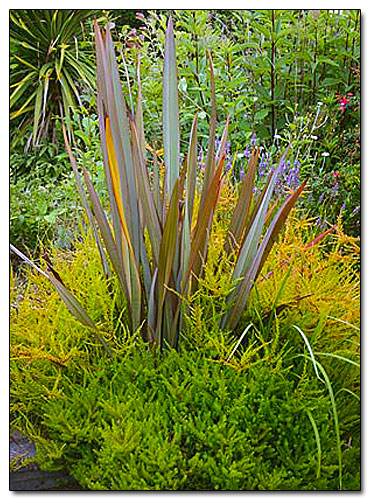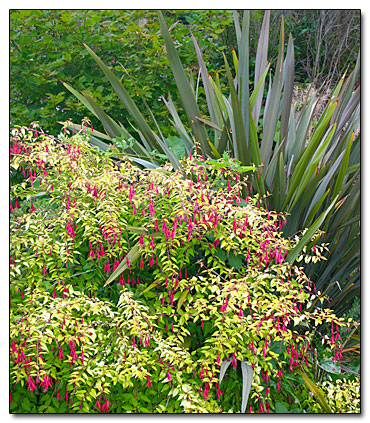Phormium tenax
NEW ZEALAND FLAX
Family: Agavaceae
Quick Jumps
Growing Guide
Rainy Side Notes
GROWING GUIDE

Plant Group:
Perennials.
Hardiness:
Sunset zones: 5,6 (will regrow after freezing to the ground), 7-9, 14-24; H1, H2.
USDA zones: 8-10.
Mature size:
Height: 12 feet (4 m) (6 feet in PNW more likely).
Width: 6 feet (2 m).
Flowering period:
Summer.
Flowering attributes:
Tubular dull red flowers.
Leaf attributes:
Linear upright leaves that can get up to 10 feet long, usually 6 feet in the Pacific Northwest.
Growth habit:
Evergreen clump forming. Unless killed to the ground by frost.
Light:
Full sun.
Soil:
Light, well-drained, fertile soil.
Propagation Methods:
Sow seed 55-64°F (13-18°C) in spring. | Divide in spring.
Rainy Side Notes

If you are looking to add drama and structure to your garden, the grass-like Phormiums will do just that. Phormiums are not really grass but are perennials. The name comes from the greek word — phormos, meaning basket. The Maori of New Zealand called the plant — Harakeke. Harakeke is one of the oldest species of plants on New Zealand. It was an important source of strong fibre for the Maori. The tradition for harvesting the leaves was to only remove the outside older leaves. The Maoris believed the layers of leaves represented family and new shoots were the children that are protected by the next outside layer of leaves thought of as the parents. The grandparents were the larger outer leaves.
Flax was used extensively for medicinal purposes. The sticky sap from the phormiums was used on wounds and boils. The root gave a juice that was used as a disinfectant. Also the leaves were used as dressings for wounds. Today it is used in soaps and shampoos, and in cosmetics.
The strong fibers were used to weave baskets, mats, clothing and even rafts were made from dried flower stalks or kokari as they were called. The nectar from the flowers was used to sweeten their food. Phormiums were an important plant to the Maoris.
In Europe the flax was imported from New Zealand to be made into rope. Even paper has been made from this versatile plant. The list of uses of this plant seems almost endless.
For a garden plant it is one that will add a structural element. The bronzy foliage of P. tenax is set off well with gold foliage plants.
Photographed in author's garden.

Gardening for the Homebrewer: Grow and Process Plants for Making Beer, Wine, Gruit, Cider, Perry, and More
By co-authors Debbie Teashon (Rainy Side Gardeners) and Wendy Tweton
Copyright Notice | Home | Search | Perennials

